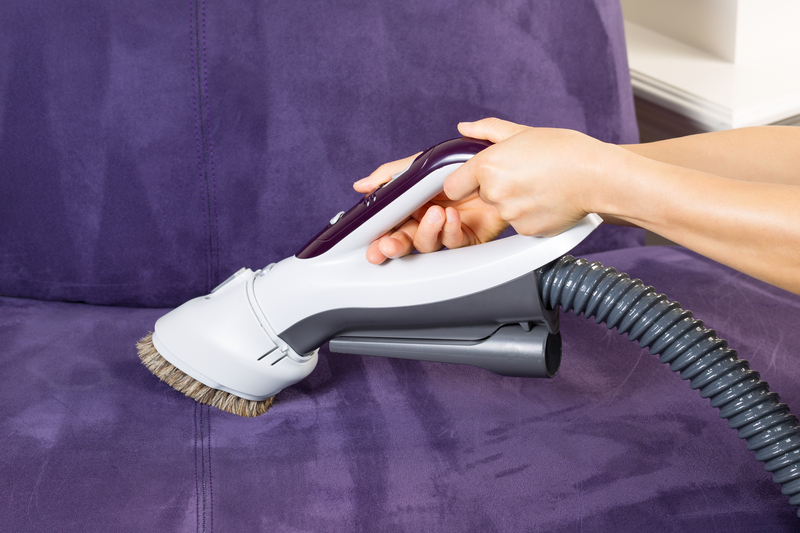Creating Healthy Indoor Ecosystems with Quality Air
Posted on 23/06/2025
Creating Healthy Indoor Ecosystems with Quality Air
Indoor air quality has become a critical concern for homeowners, businesses, and anyone seeking to lead a healthier lifestyle. As people spend more than 90% of their time indoors, the integrity of the air we breathe inside buildings profoundly impacts our overall health, comfort, and productivity. This comprehensive article will explore how to nurture healthy indoor environments and cultivate quality indoor air. We'll look at the benefits, strategies, technologies, and ongoing practices necessary for creating indoor ecosystems that support well-being.

Why is Indoor Air Quality So Important?
Our bodies require fresh, clean air to function optimally. Poor air quality indoors can lead to a range of immediate and long-term health problems, including:
- Allergies and asthma flare-ups
- Fatigue and lack of concentration
- Respiratory infections and irritation
- Long-term conditions like heart disease and cancer
Moreover, healthy indoor ecosystems with quality air have been shown to boost productivity, enhance sleep, and create an overall sense of well-being. In short, the air we breathe inside our homes and workplaces matters just as much--if not more--than the air outdoors.
The Foundations of a Healthy Indoor Environment
Understanding Common Indoor Air Pollutants
Before designing solutions for quality air indoors, it's crucial to recognize the main sources of pollution. Various contaminants can compromise indoor environments, such as:
- Volatile Organic Compounds (VOCs): Chemicals released from cleaning products, paints, and new furniture
- Particulate Matter: Dust, pollen, and microscopic allergens
- Mold and Mildew: Growths caused by moisture and high humidity
- Carbon Dioxide (CO2): From human respiration and poor ventilation
- Carbon Monoxide: A deadly gas from combustion appliances
- Radon: A naturally occurring radioactive gas seeped from soil
- Pet Dander and Biological Contaminants: From pets and pests
Many of these pollutants originate from seemingly harmless sources. The cumulative effect of poor air management can lead to what's called "sick building syndrome."
What Defines a Healthy Indoor Ecosystem?
A healthy indoor ecosystem is a balanced environment where occupants thrive physically, mentally, and emotionally. Such spaces typically feature:
- Clean, filtered air with low contaminant levels
- Optimal humidity and temperature control
- Ample natural light and adequate ventilation
- Eco-friendly materials and minimal chemical off-gassing
- Living plants or biophilic design elements
Quality indoor air is an essential component, influencing every other aspect of human health and comfort in the built environment.
Strategies for Achieving Quality Indoor Air
1. Ventilation: The Cornerstone of Air Quality
Proper ventilation helps dilute and remove indoor pollutants, replacing them with fresher outside air. Here's how you can enhance ventilation in your environment:
- Use exhaust fans in kitchens and bathrooms to eliminate moisture, smoke, and odors.
- Open windows and doors regularly, weather permitting, for a natural airflow exchange.
- Install mechanical ventilation systems like heat-recovery ventilators (HRV) or energy-recovery ventilators (ERV) for continuous air exchange in airtight homes.
These steps not only ensure better indoor air quality but also help regulate temperature and humidity.
2. Filtration and Air Purification
Quality air indoors can be achieved with the right filtration equipment:
- High-Efficiency Particulate Air (HEPA) Filters: Capture 99.97% of airborne particles as small as 0.3 microns.
- Activated Carbon Filters: Absorb gases and odors from chemicals or smoke.
- UV-C Light Purifiers: Neutralize bacteria, viruses, and mold spores.
For maximum benefit, replace HVAC filters every 3-6 months and consider standalone air purifiers for personal spaces and bedrooms.
3. Humidity Control for Healthy Indoor Ecosystems
Both high and low humidity levels can be harmful:
- Dry air irritates respiratory tracts and skin.
- Excess humidity encourages mold, dust mites, and bacteria.
Maintain indoor relative humidity between 30% and 50% using humidifiers or dehumidifiers as needed. Smart climate control devices can help auto-regulate these parameters for optimal air quality at home or in the office.
4. Source Control and Green Materials
Reducing or eliminating pollutant sources is fundamental for sustainable healthy indoor environments:
- Choose low-VOC or zero-VOC paints, adhesives, and floorings.
- Buy furniture made from natural, non-toxic materials.
- Store chemicals and cleaning agents in sealed containers and out of main living areas.
- Avoid smoking or using candles and incense indoors.
By controlling pollutant sources, you establish the foundation for lasting quality air indoors.
5. Harnessing the Power of Nature: Indoor Plants and Biophilic Design
Plants do more than beautify; they play a role in purifying indoor air:
- Spider plants, peace lilies, and snake plants are known to absorb some common VOCs.
- Plants help regulate indoor humidity by releasing water vapor during transpiration.
- Biophilic design--integrating more natural elements indoors--can reduce stress and improve cognitive function.
Living greenery is a key part of healthy indoor ecosystems, though they should complement, not replace, modern filtration.
6. Smart Home Technology for Air Quality Monitoring
Innovative smart devices help track and maintain quality indoor air 24/7:
- Indoor air quality monitors measure pollutants like PM2.5, VOCs, CO2, temperature, and humidity.
- Smart thermostats and humidifiers adjust climate conditions automatically.
- Connected air purifiers ramp up performance based on detected air quality issues.
Instant notifications enable you to address potential air problems before they escalate. Create automation routines for healthy indoor ecosystems that adjust climate and filtration based on real-time data.
Design and Lifestyle Adaptations for Indoor Ecosystem Health
Building and Renovation Tips
- Prioritize air-sealing and insulation to improve efficiency while ensuring proper ventilation strategies are in place.
- Opt for natural light sources--skylights, large windows, or glass doors--which also reduce mold-promoting dampness.
- Integrate non-toxic, sustainable materials in construction and furnishings.
Cleaning and Maintenance Best Practices
- Dust and vacuum frequently with HEPA-filtered appliances.
- Maintain HVAC systems seasonally and replace air filters regularly.
- Promptly fix leaks and water damage to prevent mold growth.
- Ventilate while cooking and after showering.
- Minimize use of chemical-based cleaners; opt for natural alternatives whenever possible.
Promoting Good Habits at Home and Work
- Remove shoes before entering to avoid tracking in pollutants.
- Discourage smoking indoors or nearby windows and doors.
- Encourage the use of green transportation and fewer fossil fuel-driven appliances.
- Foster an environment where people are educated about the importance of quality air and their role in maintaining it.
Health Benefits of Quality Indoor Air
Cultivating a healthy indoor ecosystem brings far-reaching health benefits, including:
- Reduced risk of respiratory diseases
- Relief from allergies and asthma symptoms
- Improved attention and cognitive performance
- Better mood, sleep patterns, and productivity
- Lowered risk of long-term conditions such as cardiovascular disease and cancer
According to the U.S. Environmental Protection Agency, indoor pollutants can be 2-5 times higher than outdoor levels--making quality indoor air not just a luxury but a necessity in the modern world.

Emerging Trends in Indoor Air Ecosystem Technology
Looking to the future, several innovations are shaping how we build and sustain healthy indoor ecosystems:
- Advanced filtration systems using electrostatic or photocatalytic technologies for enhanced pollutant removal
- Living wall installations in offices and schools to foster natural air purification on a large scale
- Green building certifications like LEED or WELL, guiding architects toward indoor environmental excellence
- AI-based indoor climate control adapting automatically to occupancy and air quality data
- Integration of IoT sensors providing real-time feedback and recommendations for better air management
As awareness grows, more people demand healthy indoor environments, driving a revolution in design and technology that benefits us all.
Conclusion: Making Indoor Air Quality a Daily Priority
Creating a healthy indoor ecosystem with quality air is no longer optional--it's essential for long-term health and comfort. By combining good design, smart habits, modern technology, and ongoing maintenance, anyone can transform their indoor space into a sanctuary of wellness.
Take action today: prioritize your indoor air quality and enrich your environment for better living. The air you breathe inside should be as nurturing as the lifestyles and futures you hope to build.
Frequently Asked Questions (FAQ): Creating Healthy Indoor Ecosystems with Quality Air
- How often should I change my HVAC or air purifier filters?
Typically every 3-6 months, but frequency depends on usage, local air quality, and presence of pets or allergies. - Can houseplants alone significantly improve indoor air quality?
While beneficial, plants should complement--not replace--effective ventilation and filtration. - Are there specific symptoms of poor indoor air quality?
Common signs include headaches, fatigue, coughing, throat irritation, and worsening of allergies or asthma. - What is the healthiest humidity level for indoor air?
Aim for 30-50% relative humidity to deter mold, dust mites, and bacteria while preventing dryness.
Invest in healthy indoor air--your body, mind, and home are worth it.




